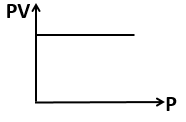The partial pressure of a dry gas is:
1. less than that of wet gas
2. greater than that of wet gas
3. equal to that of wet gas
4. none of the above
The number of molecules present in 1 mL of gas or vapor at STP is:
1. called Loschmidt's number
2. equal to 2.617 x 1019 per mL
3. both (1) and (2)
4. none of the above
Air at sea level is dense. This is a practical application of:
1. Boyle's law
2. Charles' law
3. Avogadro's law
4. Dalton's law
In van der Waals' equation of state of the gas, the constant 'b' is a measure of:
1. Intermolecular collisions per unit volume
2. Intermolecular attraction
3. Volume occupied by molecules
4. Intermolecular repulsions
For 1 mole of gas, the average kinetic energy is given as E. The urms of gas is :
1. [2E/M]1/2
2. [3E/M]1/2
3. [2E/3M]1/2
4. [3E/2M]1/2
600 cc of a gas at a pressure of 750 mm is compressed to 500 cc. Taking the temperature to remain constant, the increase in pressure is:
1. 150 mm
2. 250 mm
3. 350 mm
4. 450 mm
The curve that can not represent Boyle's law is -
1.
2.
3.
4.
The deviation of a gas from ideal behavior is expected to be minimum at -
1. 350 K and 3 atm
2. 550 K and 1 atm
3. 250 K and 4 atm
4. 450 K and 2 atm
An ideal gas expands according to PV=constant. On expansion, the temperature of the gas:
1. Will rise.
2. Will drop.
3. Will remain constant.
4. Cannot be determined because the external pressure is not known.
The correct statement for an ideal gas equation is -
1. n is the number of molecules of a gas.
2. V denotes the volume of 1 mole of the gas.
3. n moles of a gas has a volume V.
4. p is the pressure of the gas when only one mole of the gas is present.










